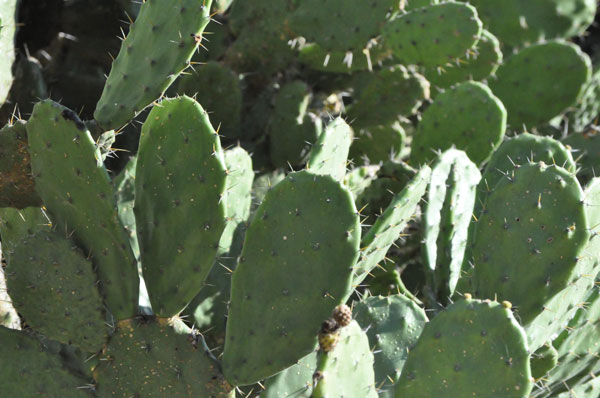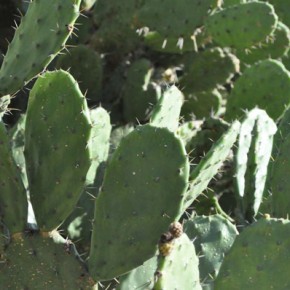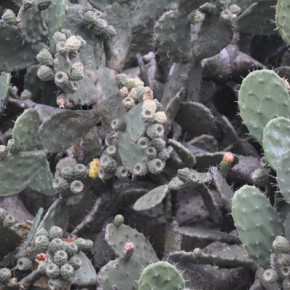A cactus salad, scrambled eggs with cactus, a cactus shake … probably doesn’t make most people’s mouths water with culinary anticipation, but nopales –the flat paddles of the Opuntia cactus– have a rich history in Mexican cuisine and are a fine addition to a healthy diet.
Nopales are so revered in Mexico that you will even see them depicted on the country’s flag, where the coat of arms displays a Mexican eagle perched upon the prickly pear cactus. Low in calories and packed with essential vitamins and minerals, nopales deserve high recognition for their nutritional value. They are also an interesting component and welcome addition to traditional Mexican fare. Best of all – nopales are inexpensive. If you plant and harvest your own, they’re free!
Some cooks and eaters are turned off to eating cactus because of baba de nopal (cactus sap). When nopales are sliced and cooked they emit slimy goo, very similar to okra. For the texture- adventurous, the slime is no problem. In various regions of Mexico there are different ways to separate the sap from the cactus before serving. Some cooks add absorbing agents to their cooking water water, including avocado leaves, tomatillo husks, a chunk of onion or a clove of garlic. Other cooks change the cooking water a few times, rinsing the slime off the nopales in between. Still others add agents such as baking soda. The slime is easily reduced, and should certainly not be a reason to avoid eating nopales.
You may want to grow and harvest your own nopal plant. If you live in Mexico you are probably in a climate suitable to grow nopales. To plant a nopal, place a paddle horizontally on the ground. Roots will form and the cactus can be harvested in about two years. To harvest a nopal paddle, use a sharp knife or break off the pad from the plant. Gloves and care should both be used to avoid getting pricked by the sharp cactus spines. The spines are removed with a knife. Take note that there are several varieties of prickly-pear (Opuntia) cactus plants, and while most are edible some plants are prized more than others.
Nutritional Value: A Mexican Super-food!
Nopales have become prized world-wide in fresh, canned, and even powdered dehydrated forms because of their amazing nutritional properties. They contain 17 amino acids (including 8 essential amino acids), vitamins (A, C, K, B6 and riboflavin), fiber (soluble and insoluble), and minerals (potassium, magnesium, manganese, iron, and copper). If you have access to nopales by all means, dig in!
People with diabetes add nopales to their meals because they are low in carbohydrates and may lower blood glucose. Those with high cholesterol eat nopales because studies show those who consume nopales regularly have a reduction in LDL cholesterol levels. Since nopales are packed with amino acids, they are a fantastic addition to a vegetarian diet.
Buying Tips
In nearly all areas of Mexico nopales are available in local fresh produce markets. This is the best way to know your cactus will be organic, and you’ll have the added knowledge that you’re supporting your local economy. Smaller, thin nopales are more flavorful than large, thick pads. In many villages indigenous women will sell nopales by the bag in various forms: cooked, chopped, or whole. Expect to pay around 10 pesos for 3-4 servings.
In the Southwest states of the USA nopales are easy to grow and are gaining popularity. They can be found in the vegetable or Mexican section of supermarkets.
In a pinch, canned nopales are now available due to the amazing nutritional profile of the prickly-pear pads. They are far less flavorful than fresh nopales but still a worthwhile addition to a Mexican meal. Be sure to rinse them well before adding them to your dish.
More on the Baba
Baba de nopal, the prickly pear slime, can be used in combination with other natural materials to make “paint” for interior and exterior use, as well as to seal roofs and rain catchment systems.
Baba de nopal has also traditionally been used to purify contaminated drinking water, though this practice is not common today. Scientists are investigating ways in which populations without access to drinking water can use the cactus, which grows readily throughout Mexico and Central America, to safely purify water.
And one more use for baba de nopal: it makes a great hair conditioner. Use the sap just as you would normal conditioner.
- Nopal cactus plants. Photos by Marie Oaks.
- Nopal cactus plants. Photo by Marie Oaks.
- Nopal cactus plants. Photo by Marie Oaks.







